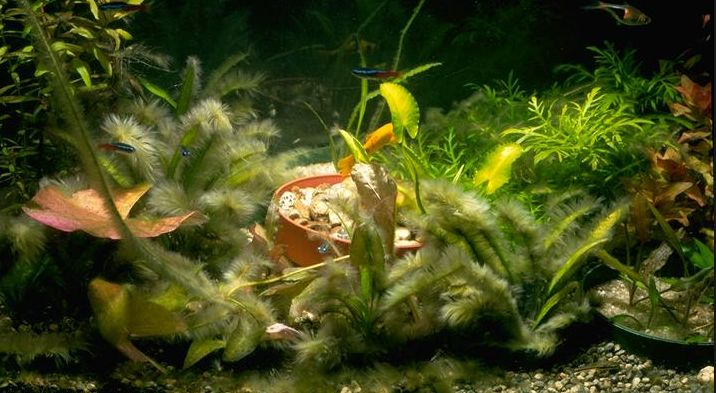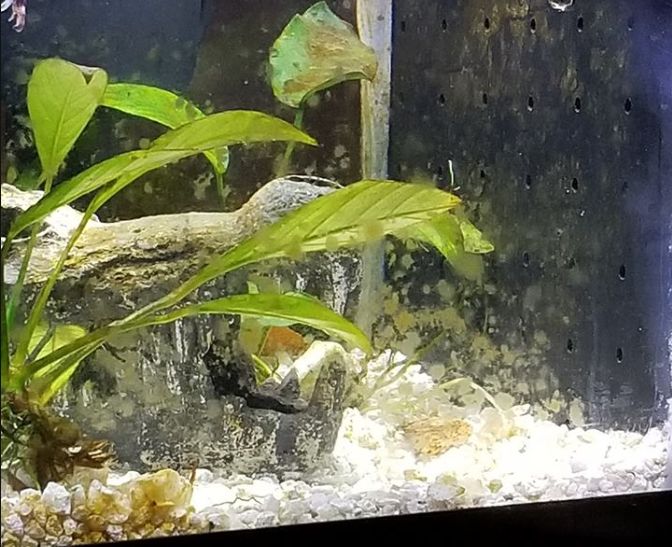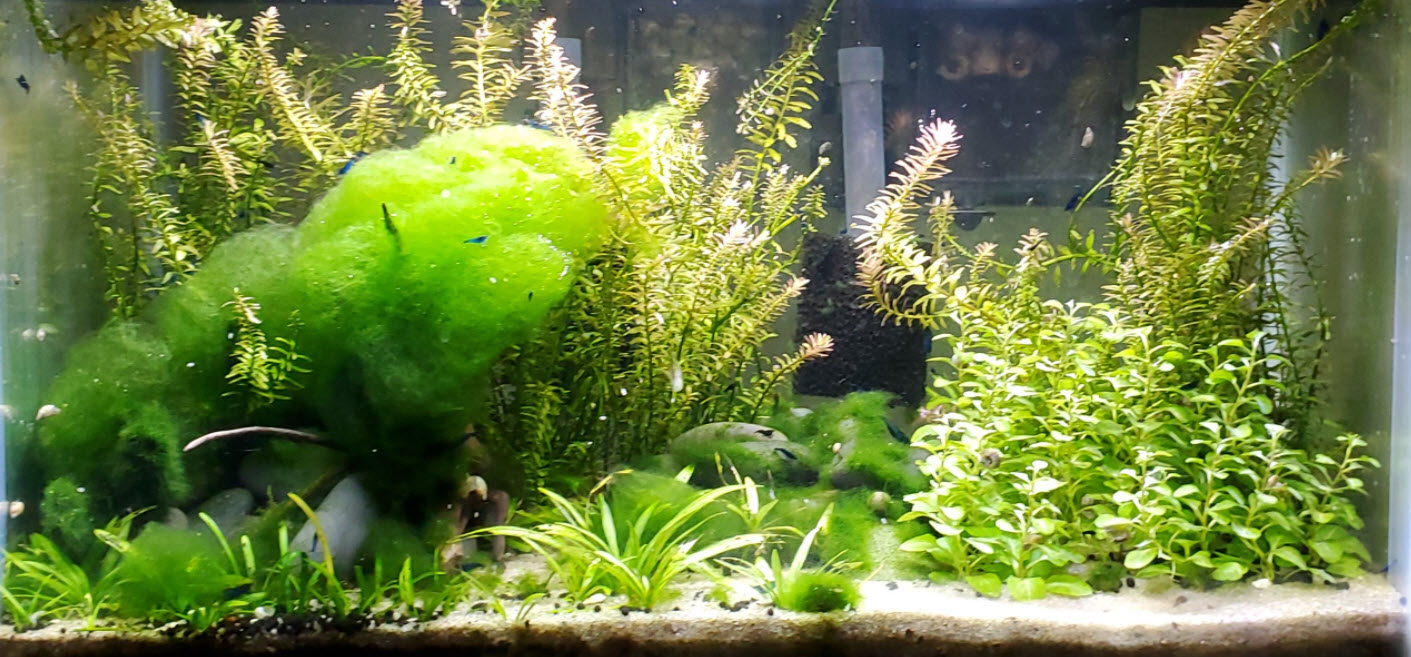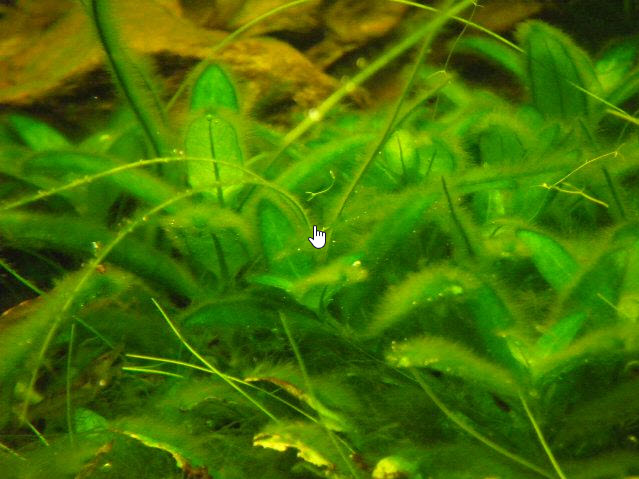By the terms “low tech planted aquarium” we mean an aquarium with vascular plants but no carbon dioxide injection.
In these types of planted aquariums heavy algae growth can be prevented by several means:
- Have a LOT of vascular plants
- Somehow add enough carbon dioxide to get the CO₂ level up to at least 10 ppm when the lights come on in the morning.
- Add phosphorus and iron ONLY to the substrate in the form of root tabs
- Add an excess of potassium to the fertilization mix
Because vascular plants have lots of carbon filled cellulose in their structures, they need more CO₂ than simple algae needs. And because vascular plants need potassium to move nutrients though their cells, vascular plants can utilize high levels of potassium quite well. Because vascular plants have roots, they can utilize phosphorus and iron which is added to the roots in the form of tabs. Algae have no roots, so they can’t get to tabs which contain phosphorus and iron.

CO₂ Levels
The CO₂ levels in a planted aquarium is very important. Most successful low tech tanks use one of several methods to get the CO₂ levels up to 10 ppm in the morning:
- The use a soil layer in the substrate that has a lot of cellulose in it which decomposes and gives the CO₂ needed (Walstad method)
- Inadvertently have a bunch of plants die and put carbon dioxide into the water as they die and decompose
- Put a large amount of fish food into the aquarium, The food decomposes and adds CO₂.
If one doesn’t do one of these things, one will rarely have any success with a low tech planted aquarium. Algae will typically take over the tank.

The Process
In order to control algae in a low tech planted tank go up and down with one variable at a time and see what happens over a time span of a month or so.
Do this with:
- Increase CO₂ (low tech bottles)
- Reducing surface water movement (higher movement = lower natural CO₂ = more algae)
- Multiple 95% to 100% water changes
- The duration of the light
- Intensity of light levels
- The spectrum of the light
- Temperatuur
- Possibly fertilizer
- Nitrogen levels in the water
- Potassium levels in the water
- Iron levels in the water (note I recommend putting iron into the soil, not the water)
- Phosphate levels in the water (note I recommend putting phosphate into the soil, not the water)
Algae can grow profusely at a huge range of any of these variables. For higher plants all these items need to be “balanced” to give a good growth of higher plants without getting a large growth of algae. For instance, a tank with very high intensity light and carbon dioxide additions can grow spectacular plants. But put high intensity light on a low tech planted Walstad aquarium with no carbon dioxide additions and the plants will be killed by a huge amount of algae.

This is a very difficult balancing act, and one needs to get very good at “experimenting”. Try ONE THING, wait two weeks, and see if there is a noticeable change. If you try two things at once and it works, which one worked? By the same token, if you try two things at once and nothing changed, did the first change help but the second change hurt and negate the first change?
Obviously this process requires a LOT of patience. Coming up with the right formula for a low tech planted aquarium can be much more challenging than a fish only aquarium or a high tech planted aquarium.
Thriving plants will generally out compete algae and kill the algae. But coming up with a formula is very difficult as there are trillions of plant, water and algae combinations possible. What works for one combination will not work for another. So when someone looks at a picture of algae in a planted tank on social media and says something like “Just reduce the lighting and the algae will go away” I just have a little chuckle. Sometimes this will work and sometimes it won’t.

Using Plants to Control Algae
One sure way to control algae is to use a LOT of vascular plants. Most people think plants control algae by absorbing nutrients. But many well planted aquariums are fed soluble fertilizers on a constant basis and don’t get algae.
This is the basis for the logic that fertilizers don’t cause algae outbreaks. What hobbyists are missing is that many higher plants give off chemicals which inhibit algae growth or even kill the algae. This is called negative allelopathy. The best way to control algae is to have vigorous plant growth over the entire aquarium. The best way to prevent algae in ANY planted tank, high tech or low tech, is to carpet the whole aquarium with vascular plants every three inches. We cover this topic in depth in the following link:

Fertilizing the Low Tech Planted Aquarium
Most low tech planted aquarium hobbyists do not fertilize other than feeding the fish. I have found that this invariably leads to the plants dying from algae. But for some it works great. I very lightly fertilize my low tech planted tanks.
As we cover in another article, planted aquariums need special attention when it come to plant nutrients. In a nutshell, the phosphorus and the iron should be supplied to the plants by special tabs put into the soil, not be additions to the water columns. Also plants are best fertilized only after they have settled in, typically three to six months after they are planted. If one fertilizes before the plants start putting out new shoots one will get smothering algae. For a complete discussion on fertilizing click the following link:
15.5. Fertilizing the Planted Aquarium

If one has added a lot of phosphorus to an aquarium and gotten a severe outbreak of algae there is one big caution. Let us say you have done three 90% water changes to remove the phosphates. And the algae die. It is not unusual at that point to get huge ammonia spikes. Dying algae release ammonia into the water column. This is the same as dumping a container of fish food into a tank. So, if there are fish in the tank, one needs to act as though one is doing a fish-in cycle.
Algae can also take over an established tank if iron is added in excess to the water column. So adding iron to the water column in a planted tank is not wise. Iron, like phosphorus, is best only added to the substrate. And if nitrate is allowed to rise above 100 ppm an outbreak of algae can be expected.

Light is important in algae control but a two edged sword. Sunlight or “plant lights” which are rich in red and blue/violet light will decidedly increase both algae and plant growth. Carbon dioxide is also a two edged sword. Like lots of light, adding carbon dioxide is beneficial to both the vascular plants and the algae.
Temperatuur
When it comes to algae, temperature is a two edged sword. Blue green algae is a bacteria. Bacteria love high temperatures. An outbreak of blue green algae (cyanobacteria) almost always occurs in aquariums over 80°F. But then blackbeard algae loves lower temperatures. The ideal temperature for plants and fish seems to be about 76 to 79°F, 24 to 26°C. For a more in depth discussion of temperature go to this link:
More Information on Controlling Algae
There is a lot more information on how to control algae in these links:
16.2. Controlling Algae in the Aquarium
16.2.1. Controlling Algae in the Fish Only Aquarium
16.2.2. Controlling Algae in the “High-Tech” Planted Aquarium


